 |
 |
|
||
 |
||||
Detailed Setting Instructions
Selecting the Scan Resolution
You can select a specific Resolution setting for your images. Keep in mind that higher resolution settings increase scanning time, so do not select a higher resolution than you need. See the following table to reference the appropriate resolution setting to use so that you do not have to take more time than necessary.
|
What you will do with the scanned image
|
Suggested scan resolution
|
|
Send via e-mail, upload to web, or view only on the screen
|
96 to 150 dpi
|
|
Print
|
300 dpi
|
|
Convert to editable text (OCR) (for documents only)
|
400 dpi
|
|
Fax
|
200 dpi
|
|
Enlarge after scanning at 100%
|
Increase Resolution setting by same amount you will increase image size after scanning.
For example, if the resolution is 300 dpi, but you will increase the image size to 200%, change the resolution setting to 600 dpi.
|
To select the resolution setting, see one of these sections.
Full Auto Mode: Selecting the Resolution in Full Auto Mode
Home Mode: Selecting the Resolution in Home Mode
Office Mode or Professional Mode: Selecting the Resolution in Office Mode or Professional Mode
Selecting the Resolution in Full Auto Mode
You can change the resolution you want at any time. Follow these steps to select the resolution setting.
 |
In the Full Auto Mode window, click Customize. The Customize window appears.
|

 |
Click the Specify resolution for Full Auto Mode check box and select the number of dpi (dots per inch) at which you want to scan.
|
Selecting the Resolution in Home Mode
To change the resolution, first select Other as the Destination setting.

Click the arrow next to the Resolution list and select the number of dpi (dots per inch) at which you want to scan.
Selecting the Resolution in Office Mode or Professional Mode
You can select the resolution you want at any time.
Office Mode
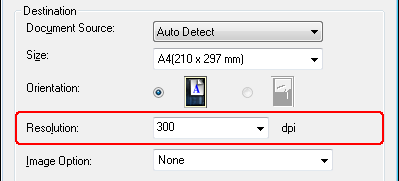
Professional Mode

Click the arrow next to the Resolution list and select the number of dpi (dots per inch) at which you want to scan.
Previewing and Adjusting the Scan Area
Once you have selected your basic settings and resolution, you can preview your image and select or adjust the image area of the image(s) in a separate Preview window on your screen. There are two types of preview.
Normal preview displays your previewed image(s) in their entirety. You must select the scan area and make any image quality adjustments manually.
Thumbnail preview displays your previewed image(s) as thumbnail(s). Epson Scan automatically locates the edges of your scan area, applies automatic exposure settings to the image(s), and rotates the image(s) if necessary.
 Note:
Note:|
If you are using Full Auto Mode and Office Mode or scanning from the ADF, the thumbnail preview is not available. You must use the normal preview.
|
 |
Click Preview. If you want to change the preview type, click the Thumbnail check box under the Preview button, if it is available.
|

 Note:
Note:|
Depending on your document type and other settings, you may not be able to change the preview type.
|
Epson Scan prescans your image(s) and displays them in one of the following Preview windows.
Normal preview

Thumbnail preview
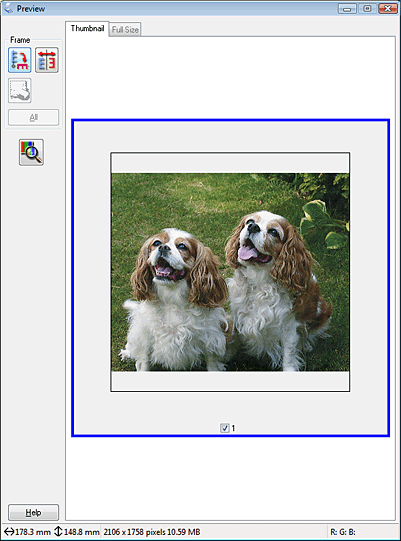
 |
If you are viewing the normal preview, you can do the following to adjust the image(s).
|
To select your scan area, click the  auto locate icon to create a marquee that marks the edges of your image area. You can move the marquee to change the scan area. See Creating a Marquee on a Preview Image for instructions.
auto locate icon to create a marquee that marks the edges of your image area. You can move the marquee to change the scan area. See Creating a Marquee on a Preview Image for instructions.
 auto locate icon to create a marquee that marks the edges of your image area. You can move the marquee to change the scan area. See Creating a Marquee on a Preview Image for instructions.
auto locate icon to create a marquee that marks the edges of your image area. You can move the marquee to change the scan area. See Creating a Marquee on a Preview Image for instructions. Note:
Note:|
If you are going to scan at a different size than your original, you must first select your Target Size and automatically create a marquee that is proportioned to that size. See Selecting the Scan Size for instructions. You can then copy the marquee and place it on each image you will scan at that size.
|
To zoom in on an image, click inside the scan area and click the Zoom button. Epson Scan prescans again and displays a larger preview on the Zoom tab.
To adjust the image quality, click the scan area(s) you want to modify and make the adjustments. See Adjusting the Color and Other Image Settings for instructions.
If you are viewing the thumbnail preview, you can do the following to adjust the image(s).
To zoom in on an image, double-click its thumbnail, or click the thumbnail and then click the Full Size tab near the top of Preview window. (This feature is only available when you are scanning multiple images at the same time.)
To rotate an image or flip it horizontally (like a mirror image), click its thumbnail and then click the  rotation icon or
rotation icon or  mirroring icon.
mirroring icon.
 rotation icon or
rotation icon or  mirroring icon.
mirroring icon. Note:
Note:|
If your image is not rotated correctly, see Images are Rotated Incorrectly.
|
To adjust the scan area to crop your image differently, you can create and move a marquee that marks the edges of your scan. See Creating a Marquee on a Preview Image for instructions.
To adjust the image quality, click the image(s) or scan area(s) you want to modify and make the adjustments. See Adjusting the Color and Other Image Settings for instructions. If you want to apply the adjustments you have made to all of your images, click All.
Creating a Marquee on a Preview Image
A marquee is a moving dotted line that appears on the edges of your preview image to indicate the scan area.
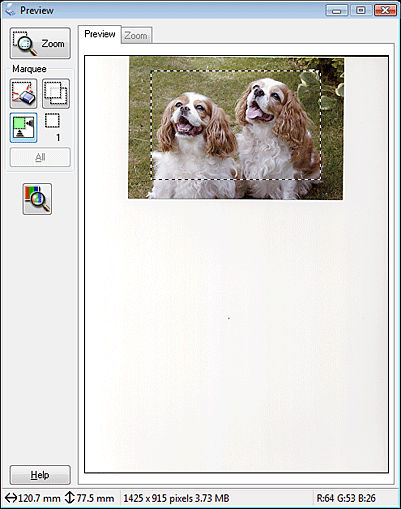
You can move the marquee and adjust its size. If you are viewing the normal preview, you can create multiple marquees (up to 50) on each image to scan different image areas in separate scan files.
 |
To draw a marquee, move your cursor over a preview image. The pointer becomes a set of cross-hairs.
|
 Note:
Note:|
If you are viewing the normal preview and you only have one photo on the document table, you can click the
 auto locate icon to automatically draw a marquee, then skip to step 3. auto locate icon to automatically draw a marquee, then skip to step 3. |
 |
Position the pointer in the area where you want to place the corner of your marquee and click. Hold down the mouse button and drag the cross-hairs over the image to the opposite corner of the desired scan area. Then release the mouse button. You see the moving dotted line of the marquee.
|

 |
Do one of the following to adjust the marquee.
|
To move the marquee, position your cursor inside the marquee. The pointer becomes a hand. Click and drag the marquee to desired location.

To resize the marquee, position your cursor over the edge or corner of the marquee. The pointer becomes a straight or angled double-arrow. Click and drag the edge or corner to the desired size.
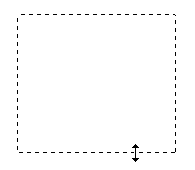
 Note:
Note:|
To restrict the movement of the marquee to vertical or horizontal only, hold down the Shift key as you move the marquee.
To restrict the size of the marquee to the current proportions, hold down the Shift key as you resize the marquee.
For best results and image exposure, make sure all sides of the marquee are located inside the preview image. Do not include any of the area around the preview image in the marquee.
|
 |
If you are viewing the normal preview, you can create multiple marquees (up to 50). Just draw them as described in steps 1 through 3, or click the
 copy marquee icon to create additional marquees of the same size. You can move and resize all the marquees as described in step 3. To delete a marquee, click inside it and click the copy marquee icon to create additional marquees of the same size. You can move and resize all the marquees as described in step 3. To delete a marquee, click inside it and click the  delete marquee icon. delete marquee icon. |
 Note:
Note:|
If you draw multiple marquees, make sure you click All in the Preview window before you scan. Otherwise, only the area inside the last marquee you drew will be scanned.
|
Adjusting the Color and Other Image Settings
Once you have previewed your image(s) and adjusted the scan area, you can modify the image quality, if necessary. Epson Scan offers a variety of settings for improving color, sharpness, contrast, and other aspects affecting image quality. Before you make adjustments, be sure to click the image or marquee for the area you want to adjust.
To adjust the color and other image settings, see one of these sections.
Professional Mode: Making Color Adjustments and Other Image Settings in Professional Mode
Making Color Adjustments and Other Image Settings in Office Mode

The table below describes the settings available in Office Mode. For details on adjusting these settings, see Epson Scan Help.
 Note:
Note:
 Note:
Note:|
If you are scanning multiple images at the same time and you want to apply the image adjustments to all of your images or scan areas, click All in the Preview window before you begin making your adjustments.
|
|
Setting
|
Description
|
|
|
Unsharp Mask
|
Turn on to make the edges of image areas clearer for an overall sharper image. Turn off to leave softer edges. This setting is available only when the Image Type is set to Color or Grayscale.
|
|
|
Descreening
|
Removes the rippled pattern that can appear in subtly-shaded image areas, such as in skin tones. Also improves results when scanning magazine or newspaper images which include screening in their original print processes. This setting is available only when the Image Type is set to Color or Grayscale. The results of descreening do not appear in the preview, only in your scanned image.
|
|
|
Image Option
|
Text Enhancement
|
Enhances text recognition when scanning text documents.
This setting is available in the following conditions: - when the Image Type is set to Color and Image Option is selected - when the Image Type is set to Grayscale and Image Option is selected - when the Image Type is set to Black&White and Image Option is selected When the Image Type is set to Black&White, the results of Text Enhancement do not appear in the preview, only in your scanned image.
|
|
Auto Area Segmentation
|
Makes grayscale images clearer and text recognition more accurate by separating the text from the graphics. This setting is available only when the Image Type is set to Black&White and Image Option is selected.
|
|
|
Color Enhance
|
Enhances red, green, or blue in the scan.
This setting is available in the following conditions: - when the Image Type is set to Grayscale and Image Option is selected - when the Image Type is set to Black&White and Image Option is selected |
|
|
Brightness
|
Adjusts the overall image lightness and darkness.
This setting is available in the following conditions: - when the Image Type is set to Color - when the Image Type is set to Grayscale - when the Image Type is set to Black&White, and Image Option and Auto Area Segmentation are selected |
|
|
Contrast
|
Adjusts the difference between the light and dark areas of the overall image.
This setting is available in the following conditions: - when the Image Type is set to Color - when the Image Type is set to Grayscale - when the Image Type is set to Black&White, and Image Option and Auto Area Segmentation are selected |
|
|
Threshold
|
Adjusts the level at which the black areas in text and line art are delineated, improving text recognition in OCR programs.
This setting is available in the following conditions: - when the Image Type is set to Black&White, and Image Option is not selected - when the Image Type is set to Black&White, and Image Option and Color Enhance are selected |
|
 Note:
Note:|
To view the red, green, and blue levels at particular points in your preview image as you make adjustments, click the
 densitometer icon in the Preview window and move your cursor over an image area. See Epson Scan Help for details. densitometer icon in the Preview window and move your cursor over an image area. See Epson Scan Help for details.Certain settings may not be available, or may be automatically selected, depending on the type of image you are previewing and other settings you have selected.
You can customize how certain Epson Scan settings behave by clicking Configuration and changing settings in the window that appears. See Epson Scan Help for details.
To undo any image quality adjustments you make to the preview image, click Reset if available, turn off the settings, or preview your image again.
|
Making Color Adjustments and Other Image Settings in Home Mode
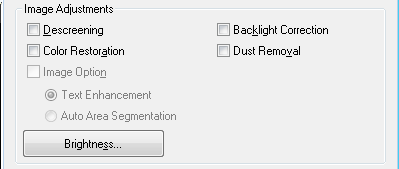
The table below describes the settings available in Home Mode. For details on adjusting these settings, see Epson Scan Help.
 Note:
Note:
 Note:
Note:|
If you are scanning multiple images at the same time and you want to apply the image adjustments to all of your images or scan areas, click All in the Preview window before you begin making your adjustments.
|
|
Setting
|
Description
|
|
|
Descreening
|
Removes the rippled pattern that can appear in subtly-shaded image areas, such as in skin tones. Also improves results when scanning magazine or newspaper images which include screening in their original print processes.
This setting is available in the following conditions:
- when the Image Type is set to Color - when the Image Type is set to Grayscale The results of descreening do not appear in the preview, only in your scanned image. |
|
|
Backlight Correction
|
Removes shadows from photos that have too much background light.
This setting is available in the following conditions:
- when you select Photograph as the Document Type setting and Image Type is set to Color - when you select Photograph as the Document Type setting and Image Type is set to Grayscale |
|
|
Color Restoration
|
Restores the colors in faded photos automatically.
This setting is available in the following conditions:
- when you select Photograph as the Document Type setting, and Image Type is set to Color - when you select Photograph as the Document Type setting, and Image Type is set to Grayscale |
|
|
Dust Removal
|
Removes dust marks from your originals automatically. The results of Dust Removal do not appear in the preview, only in your scanned image.
This setting is available in the following conditions:
- when you select Photograph as the Document Type setting and Image Type is set to Color - when you select Photograph as the Document Type setting and Image Type is set to Grayscale |
|
|
Image Option
|
Text Enhancement
|
Enhances text recognition when scanning text documents.
This setting is available in the following conditions:
- when you select Magazine as the Document Type setting and Image Option is selected - when you select Newspaper as the Document Type setting and Image Option is selected - when you select Text/Line Art as the Document Type setting and Image Option is selected |
|
Auto Area Segmentation
|
Makes grayscale images clearer and text recognition more accurate by separating the text from the graphics.
This setting is available in the following conditions: - when you select Magazine as the Document Type, the Image Type is set to Black&White, and Image Option is selected - when you select Newspaper as the Document Type, the Image Type is set to Black&White, and Image Option is selected - when you select Text/Line Art as the Document Type, the Image Type is set to Black&White, and Image Option is selected |
|
|
Brightness
|
Adjusts the overall image lightness and darkness.
This setting is available in the following conditions:
- when the Image Type is set to Color - when the Image Type is set to Grayscale - when you select Magazine as the Document Type setting, the Image Type is set to Black&White, and Image Option and Auto Area Segmentation are selected - when you select Newspaper as the Document Type setting, the Image Type is set to Black&White, and Image Option and Auto Area Segmentation are selected - when you select Text/Line Art as the Document Type setting, the Image Type is set to Black&White, and Image Option and Auto Area Segmentation are selected Click Brightness to access the Brightness setting.
|
|
|
Contrast
|
Adjusts the difference between the light and dark areas of the overall image.
This setting is available in the following conditions:
- when the Image Type is set to Color - when the Image Type is set to Grayscale - when you select Magazine as the Document Type setting, the Image Type is set to Black&White, and Image Option and Auto Area Segmentation are selected - when you select Newspaper as the Document Type setting, the Image Type is set to Black&White, and Image Option and Auto Area Segmentation are selected - when you select Text/Line Art as the Document Type setting, the Image Type is set to Black&White, and Image Option and Auto Area Segmentation are selected Click Brightness to access the Contrast setting.
|
|
|
Threshold
|
Adjusts the level at which the black areas in text and line art are delineated, improving text recognition in OCR programs.
Available only when the Image Type is set to Black&White, and Image Option is not selected.
Click Brightness to access the Threshold setting.
|
|
 Note:
Note:|
To view the red, green, and blue levels at particular points in your preview image as you make adjustments, click the
 densitometer icon in the Preview window and move your cursor over an image area. See Epson Scan Help for details. densitometer icon in the Preview window and move your cursor over an image area. See Epson Scan Help for details.Certain settings may not be available, or may be automatically selected, depending on the type of image you are previewing and other settings you have selected.
You can customize how certain Epson Scan settings behave by clicking Configuration and changing settings in the window that appears. See Epson Scan Help for details.
To undo any image quality adjustments you make to the preview image, click Reset if available, turn off the settings, or preview your image again.
|
Making Color Adjustments and Other Image Settings in Professional Mode

The table below describes the settings available in Professional Mode. For details on adjusting these settings, see Epson Scan Help.
 Note:
Note:|
You may need to scroll down to view the Adjustments area of the Professional Mode window.
If you are scanning multiple images at the same time and you want to apply the image adjustments to all of your images or scan areas, click All in the Preview window before you begin making your adjustments.
|
|
Setting
|
Description
|
|
Auto Exposure
|
Click the
 Auto Exposure icon. To turn it on continuously, click Configuration, click the Color tab and select Continuous auto exposure. You can adjust the level of exposure adjustment using the slider. Auto Exposure icon. To turn it on continuously, click Configuration, click the Color tab and select Continuous auto exposure. You can adjust the level of exposure adjustment using the slider. |
|
Histogram
|
Provides a graphical interface for adjusting highlight, shadow, and gamma levels individually. For advanced users only.
Click the
 Histogram Adjustment icon to access the Histogram setting. Histogram Adjustment icon to access the Histogram setting. |
|
Tone Correction
|
Provides a graphical interface for adjusting tone levels individually. For advanced users only.
Click the
 Tone Correction icon to access the Tone Correction setting. Tone Correction icon to access the Tone Correction setting. |
|
Brightness
|
Adjusts the overall image lightness and darkness.
Click the
 Image Adjustment icon to access the Brightness setting. Image Adjustment icon to access the Brightness setting. |
|
Contrast
|
Adjusts the difference between the light and dark areas of the overall image.
Click the
 Image Adjustment icon to access the Contrast setting. Image Adjustment icon to access the Contrast setting. |
|
Saturation
|
Adjusts the density of colors in the overall image.
Click the
 Image Adjustment icon to access the Saturation setting. Image Adjustment icon to access the Saturation setting. |
|
Color Balance
|
Adjusts the balance of red, green, and blue colors in the overall image.
Click the
 Image Adjustment icon to access the Color Balance settings. Image Adjustment icon to access the Color Balance settings. |
|
Color Palette
|
Provides a graphical interface for adjusting mid-tone levels, such as skin tones, without affecting the highlight and shadow areas of the image. For advanced users only. See Using the Color Palette Feature (for Professional Mode Only) for more information.
Click the
 Color Palette icon to use the Color Palette settings. Color Palette icon to use the Color Palette settings. |
|
Unsharp Mask
|
Turn on to make the edges of image areas clearer for an overall sharper image. The level of sharpness is adjustable. Turn off to leave softer edges.
This setting is available in the following conditions: - when the Image Type is set to 24-bit Color - when the Image Type is set to 8-bit Grayscale |
|
Descreening
|
Removes the rippled pattern that can appear in subtly shaded image areas, such as skin tones. Also improves results when scanning magazine or newspaper images that include screening in their original print processes. The results of descreening do not appear in the preview, only in your scanned image. The level of descreening is adjustable.
This setting is available in the following conditions: - when the Image Type is set to 24-bit Color - when the Image Type is set to Color Smoothing - when the Image Type is set to 8-bit Grayscale |
|
Color Restoration
|
Restores the colors in faded photos automatically.
This setting is available in the following conditions: - when you select Photo as the Auto Exposure Type setting and the Image Type is set to 24-bit Color - when you select Photo as the Auto Exposure Type setting and the Image Type is set to 8-bit Grayscale |
|
Backlight Correction
|
Removes shadows from photos that have too much background light. the level of backlight correction is adjustable.
This setting is available in the following conditions: - when you select Photo as the Auto Exposure Type setting and the Image Type is set to 24-bit Color - when you select Photo as the Auto Exposure Type setting and the Image Type is set to 8-bit Grayscale |
|
Dust Removal
|
Removes dust marks from your originals automatically. The results of Dust Removal do not appear in the preview, only in your scanned image. The level of dust removal is adjustable.
This setting is available in the following conditions: - when you select Photo as the Auto Exposure Type setting and the Image Type is set to 24-bit Color - when you select Photo as the Auto Exposure Type setting and the Image Type is set to 8-bit Grayscale |
|
Threshold
|
Adjusts the level at which the black areas in text and line art are delineated, improving text recognition in OCR programs. Available only when you select Black & White as the Image Type setting.
|
 Note:
Note:|
To view red, green, and blue levels at particular points in your preview image as you make adjustments, click the
 densitometer icon in the Preview window and move your cursor over an image area. See Epson Scan Help for details. densitometer icon in the Preview window and move your cursor over an image area. See Epson Scan Help for details.Certain settings may not be available, or may be automatically selected, depending on the type of image you are previewing and other settings you have selected.
You can customize how certain Epson Scan settings behave by clicking Configuration and changing settings in the window that appears. See Epson Scan Help for details.
To undo any image quality adjustments you make to the preview image, click Reset if available, turn off the setting, or preview your image again.
|
Selecting the Scan Size
You can scan your images at their original size, or you can reduce or enlarge their size as you scan them. You do this using the Target Size setting.
If you are going to scan your image to a specific size, you should select the Target Size setting after previewing it, but before adjusting your scan area indicated by creating a marquee. This sets the scan area to correct proportions so your image will not be cropped unexpectedly.
To select the scan size, see one of these sections.
Home Mode: Selecting the Scan Size in Home Mode
Professional Mode: Selecting the Scan Size in Professional Mode
Selecting the Scan Size in Home Mode

 |
You can select a predefined scan size from the Target Size list. Click the arrow to open the list and select the size you want. A marquee (dotted line) proportioned for that size appears on your preview image.
|

 |
If you need to create a scan size that is not in the Target Size list, you can create a custom size. Click the arrow to open the list and select Customize. You see the Target Size window.
|

 |
Type a name for your custom size, enter the size, click Save, then click OK. Your new size appears in the Target Size list.
|
 |
Once you have selected your scan size, you can click and drag the marquee to the area in the image you want to scan. For details, see Creating a Marquee on a Preview Image. The marquee proportions are retained as you adjust it.
|
If you need to rotate the marquee for a landscape or portrait image without changing its aspect ratio, click the  orientation icon.
orientation icon.
 orientation icon.
orientation icon.  Note:
Note:|
The
 orientation icon is not available if you selected Original as the Target Size setting. orientation icon is not available if you selected Original as the Target Size setting. |
Selecting the Scan Size in Professional Mode
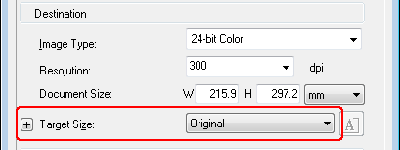
 |
You can select a predefined scan size from the Target Size list. Click the arrow to open the list and select the size you want. A marquee (dotted line) proportioned for that size appears on your preview image.
|

 |
If you need to create a scan size that is not in the Target Size list, you can create a custom size. Click the arrow to open the list and select Customize. You see the Target Size window.
|

 |
Type a name for your custom size, enter the size, click Save, then click OK. Your new size appears in the Target Size list.
|
 |
You can fine-tune the size using additional tools. Click the + (Windows) or
 (Mac OS X) button next to Target Size to display these tools. (Mac OS X) button next to Target Size to display these tools. |

To size your image by a certain percentage, adjust the Scale value.
To change the way your image is cropped, turn Trimming on or off. See Epson Scan Help for details.
To unlock the proportions of your scan size, click the  lock icon. Then adjust the marquee or enter new width/height measurements.
lock icon. Then adjust the marquee or enter new width/height measurements.
 lock icon. Then adjust the marquee or enter new width/height measurements.
lock icon. Then adjust the marquee or enter new width/height measurements. |
Once you have selected your scan size, you can click and drag the marquee to the area in the image you want to scan. For details, see Creating a Marquee on a Preview Image. The marquee proportions are retained as you adjust it.
|
If you want to rotate the marquee for a landscape or portrait image without changing its aspect ratio, click the  orientation icon.
orientation icon.
 orientation icon.
orientation icon. Note:
Note:|
The
 orientation icon is not available if you selected Original as the Target Size setting. orientation icon is not available if you selected Original as the Target Size setting. |
